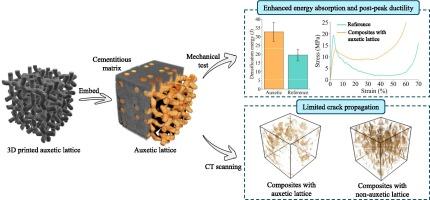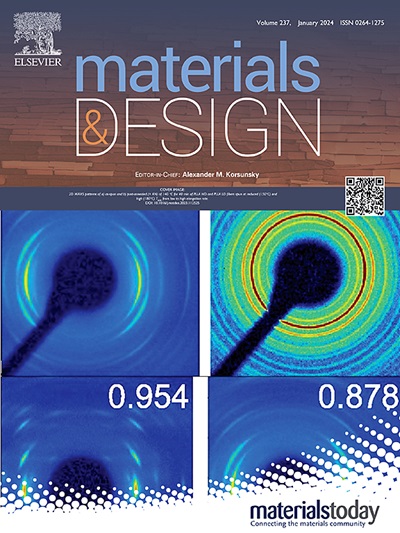Unraveling the reinforcing mechanisms for cementitious composites with 3D printed multidirectional auxetic lattices using X-ray computed tomography
IF 7.6
2区 材料科学
Q1 MATERIALS SCIENCE, MULTIDISCIPLINARY
引用次数: 0
Abstract
This study investigates the mechanical properties of cementitious composites with 3D-printed auxetic lattices, featuring negative Poisson’s ratios (auxetic behavior) in multiple directions. These lattices were fabricated using vat photopolymerization 3D printing, and three base materials with varying stiffness and deformation capacities were analyzed to determine their impact on the composites’ mechanical behavior. To unravel the reinforcing mechanisms of multidirectional auxetic lattices, which exhibit auxetic behavior in both planar and out-of-plane directions, X-ray computed tomography (X-ray CT) was utilized to analyze composite damage evolutions under different strain levels. The micro-CT characterization reveals that auxetic lattices more effectively constrain crack growth and dissipate energy by distributing stress evenly within the cement matrix. In contrast, due to lack of lateral confinement, the non-auxetic lattice reinforced composites primarily dissipate energy through extensive crack propagation and interfacial damage, leading to lower peak strength. When strain exceeding 5%, although the confinement from the auxetic behavior diminished with crack propagation, the lattice can still maintain the composite’s structural integrity, resulting in 1.7 times higher densification energy than conventional cement-based materials. These findings provide valuable insights for designing auxetic lattice-reinforced cementitious composites with enhanced load-bearing capacity and improved dissipation capabilities.

利用 X 射线计算机断层扫描揭示带有 3D 打印多向辅助晶格的水泥基复合材料的增强机制
本研究探讨了具有三维打印辅助网格的水泥基复合材料的力学性能,这些网格在多个方向上具有负泊松比(辅助行为)。这些晶格是使用大桶光聚合三维打印技术制造的,并分析了三种具有不同刚度和变形能力的基材,以确定它们对复合材料机械行为的影响。多向辅助网格在平面和平面外两个方向上都表现出辅助行为,为了揭示多向辅助网格的增强机制,研究人员利用 X 射线计算机断层扫描(X 射线 CT)分析了不同应变水平下的复合材料损伤演变。微计算机断层扫描表征显示,辅助晶格能更有效地限制裂纹生长,并通过在水泥基质中均匀分布应力来消散能量。相反,由于缺乏横向约束,非磁性晶格增强复合材料主要通过广泛的裂纹扩展和界面破坏来耗散能量,从而导致峰值强度降低。当应变超过 5%时,虽然辅助行为产生的约束会随着裂纹扩展而减弱,但晶格仍能保持复合材料的结构完整性,从而使其致密化能量比传统水泥基材料高出 1.7 倍。这些发现为设计具有更强承载能力和更佳耗散能力的辅助晶格增强水泥基复合材料提供了宝贵的启示。
本文章由计算机程序翻译,如有差异,请以英文原文为准。
求助全文
约1分钟内获得全文
求助全文
来源期刊

Materials & Design
Engineering-Mechanical Engineering
CiteScore
14.30
自引率
7.10%
发文量
1028
审稿时长
85 days
期刊介绍:
Materials and Design is a multi-disciplinary journal that publishes original research reports, review articles, and express communications. The journal focuses on studying the structure and properties of inorganic and organic materials, advancements in synthesis, processing, characterization, and testing, the design of materials and engineering systems, and their applications in technology. It aims to bring together various aspects of materials science, engineering, physics, and chemistry.
The journal explores themes ranging from materials to design and aims to reveal the connections between natural and artificial materials, as well as experiment and modeling. Manuscripts submitted to Materials and Design should contain elements of discovery and surprise, as they often contribute new insights into the architecture and function of matter.
 求助内容:
求助内容: 应助结果提醒方式:
应助结果提醒方式:


